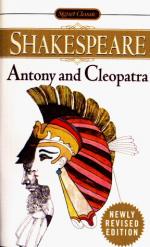|
This section contains 4,013 words (approx. 14 pages at 300 words per page) |

|
SOURCE: Kinney, Clare. “The Queen's Two Bodies and the Divided Emperor: Some Problems of Identity in Antony and Cleopatra.” In The Renaissance Englishwoman in Print: Counterbalancing the Canon, edited by Anne M. Haselkorn and Betty S. Travitsky, pp. 177-86. Amherst: University of Massachusetts Press, 1990.
In the following essay, Kinney contends that Cleopatra is the human embodiment of Egypt and represents an all-inclusive potentiality that embraces the feminine and the masculine.
Cleopatra, like Falstaff, is always being called names. Almost every scene in Antony and Cleopatra generates new identities for her; over the course of the play she acquires at least forty different cognomens. She is gypsy, whore, trull, vile lady, grave charm, morsel, boggler, salt Cleopatra; she is great fairy, nightingale, serpent of old Nile, Egyptian dish; she is, furthermore, most sovereign creature, great Egypt, day o' th' world, lass unparalleled. Constantly avoiding the numerous (and largely male...
|
This section contains 4,013 words (approx. 14 pages at 300 words per page) |

|


